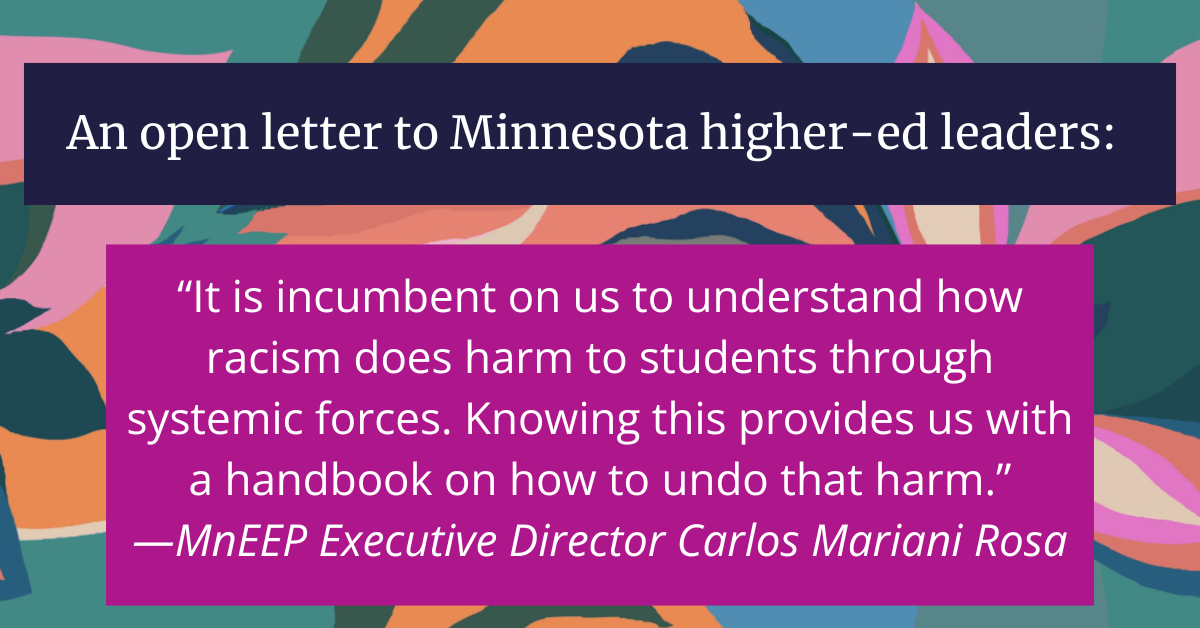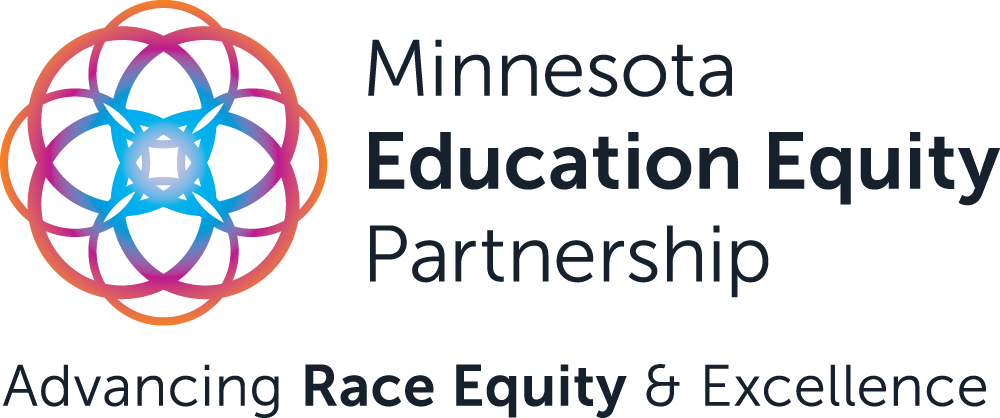
What Minnesota colleges and university’s must ask themselves right now
MnEEP Executive Director speech to higher-ed leaders at the P20 event.
MnEEP’s mission is to transform education systems to advance race equity and education excellence.
We know the factors contributing to the wellbeing of our People of Color and Indigenous (POCI) communities are often distinct from the experiences of white communities that make up the majority of our population and around which our credentialing environments were designed.
And yet People of Color Indigenous people (POCI) will increasingly makeup the age groups that all of our social and economic systems will depend on for success. Their post-secondary achievement of knowledge and skills will increasingly determine the well-being of our state. Addressing their unique conditions is not only morally correct, but also necessary for our collective good.
To equip them for their success —for our collective success —we must acknowledge the powerful presence of racism in our society and how it lives in the operations of our social institutions, inclusive that of our higher education systems.
By now you surely know that acknowledging the impact of racism requires more than a focus on individual bias.
In complex ways, racism is mostly invisible, making it difficult to address without a mature understanding of how it works. It lives implanted into systems as unwritten policies and entrenched practices and beliefs. Often the policies are indirect and more about what is left unacknowledged, and what is not accounted for, that nevertheless is present in the lives POCI people.
This practice of omission can determine access to the benefits that are otherwise provided by the system. It is vital we be clear that even when we are not consciously trying to our practices produce, condone, and perpetuate widespread unfair treatment and oppression of POCI people.
It is incumbent on us to understand how racism does harm to students through systemic forces. Knowing this provides us with a handbook on how to undo that harm.
As sociologist Dr. Eduardo Bonilla-Silva, a scholar on systemic racism and education, shares:
“The only way to ‘cure’ society of racism is by eliminating its systemic roots.” [1]
For example, student financial aid is designed to factor in the economic realities of a conventional household, but it does not account for when that household financially supports extended family, even friends, who are suffering social and economic stress.
The conventional scenario makes common sense in a world where the measure of financial obligation is limited to our dominant society’s notion of a nuclear family where no primary financial obligation outside of parents and their children is considered “normal”. Our governmental aid formulas are informed by that norm.
But that may not be commonsensical to all families. The diversity of cultural expectations means that many households face unavoidable duties to care for loved ones outside of their nuclear family, including those harmed by racism and poverty. This has real implications for college affordability. For a deeper look at this, see the MnEEP 2020 policy brief “Reducing Racial Disparities in College Completion”
And so, student financial aid formulas may result in racially disparate impacts given the makeup of many homes in POCI communities. The aid design may provide aid that Is insufficient to make post-secondary participation a successful one.
In fact, the numbers of students not completing post-secondary who hold debt for having once attended college is a dominant feature among POCI communities, especially among African Americans. In surveys conducted by LendEDU [2] the plurality of college dropouts, 35%, cited “financial reasons” as the main reason for leaving their respective college campuses. Trailing closely behind was “social/family reasons,” which brought in 34 % of the responses.
In sum:
Structural racism systematically advantages dominant social groups and disadvantages marginalized groups while engaging in processes that are normalized as being neutral or of common sense.
The quantitative data being shared today tells us a story of some success—as measured by large numbers of Minnesotans accessing the fruits of higher education. It even shows some positive movement among POCI students.
But it also points to important missed opportunities, even failures. Because the data still shows racially and income disparate outcomes, it paints a concerning picture for our state’s future well-being and the well-being of certain communities, those of low and modest wealth and of POCI communities.
For the MN P20, charged by state law to “work toward ensuring a seamless system of education across the state, with the goal of maximizing success for all of Minnesota’s learners from birth through adulthood” a policy question arising from the data is whether the reality represented is a sustainable one for meeting that purpose and for ensuring a socially healthy state.
As we engage today, I urge you to keep that equity question in mind.
And if you find that healthy sustainability is not present, MnEEP proposes that you consider a theory of change advanced by Ed Trust [3] that is informed by a thorough understanding of systemic racism and thus calls for “a more radical, critical approach for action.”
This used to involve radical thinking, MnEEP’s earliest days felt like screaming into the wind – but no longer. The post-secondary institutions that you are part of have a much stronger working knowledge of racism and how it impacts their mission. And that is true across many sectors of our society now.
Speaking from one of those sectors, the American Medical Association for instance has a mature definition of Structural (or Systemic) racism referring to it as “the totality of ways in which societies foster racial discrimination through mutually reinforcing systems of housing, education, employment, earnings, benefits, credit, media, health care and criminal justice” [4]
This understanding calls on each sector to not defer to the other for addressing racial harm but rather that each assume responsibility for interrupting racism. It’s simply not good enough for our higher-ed sector to accept the limits that any of the other sectors create for POCI students —such as limiting their income — but rather, to be part of counteracting for how those limitations get in the way of the mission of post-secondary.
Interrupting how racism appropriates your mission in higher education is the action sought.
I submit that this involves creatively shifting our state’s higher education policy frame to:
- Increasingly target our resources to those most harmed by racism and poverty,
- Partner with student themselves for designing systems of support and shaping the learning environment,
- Engage those communities directly in designing and holding our institutions of higher learning accountable to the development of skills and knowledge among POCI communities and low-income communities.
Stepping into the policy arena is not easy work. Those who are not part of the systems needing change suffer from lack of knowledge of the complexity of managing such systems. On the other hand, those who are part of those systems suffer from resistance to change.
Yet the work is needed unless we are content to follow the path the current data about college access and graduation rates reveals here today. As someone who was a statewide policy maker, I would both celebrate where we are successful while asking whether this is the best we can do with the massive amounts of resources we invest in our state’s higher ed sector. I would need those in the field to show me how we could do better and I would need my frame of what are normal processes for success to be challenged.
Like all things, today’s inquiry leads us to engage in defining our purpose. I can think of few greater purposes for our systems of higher education than to lead on dismantling racism and affirming humanity. That we can intentionally strive for that while contributing to the development of knowledge and skills needed to build a healthy and prosperous society, is the proverbial “icing on the cake”. So, let’s joyfully engage in this work together.
============
[1] Eduardo Bonilla-Silva, American Sociological Review, 1996, Vol. 62 “Rethinking Racism: Toward a Structural Interpretation” [2] https://lendedu.com/blog/college-dropouts-student-loan-debt/ [3] https://edtrust.org/resource/to-dismantle-structural-racism-in-college-recruiting-policymakers-and-advocates-must-play-offense-not-defense/ [4] Bailey ZD, Krieger N, Agenor M, Graves J, Linos N, Bassett MT. Structural racism and health inequities in the USA: evidence and interventions. Lancet. 2017; 389 (10077):1453-1463. Zinzi Bailey, ScD, MSPH, et al.1

